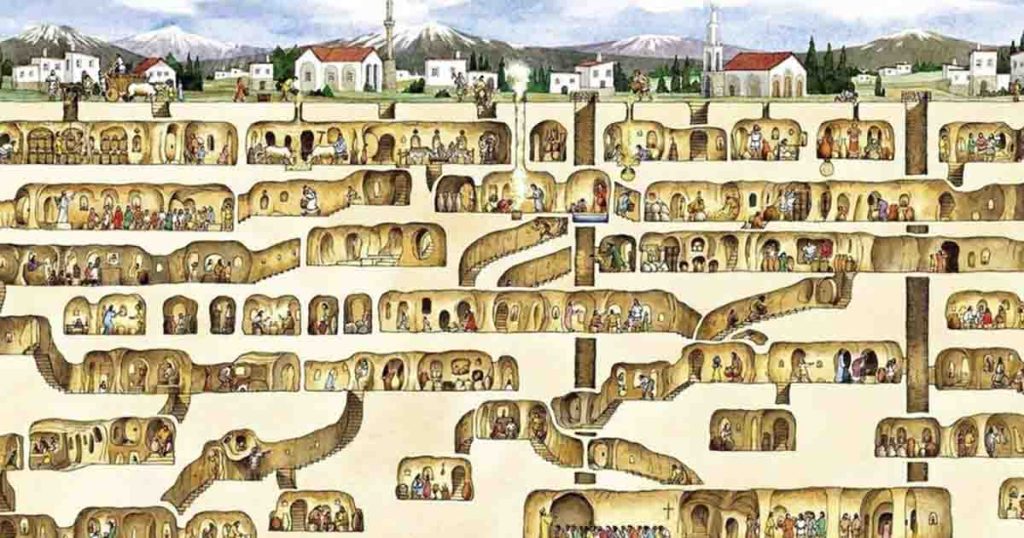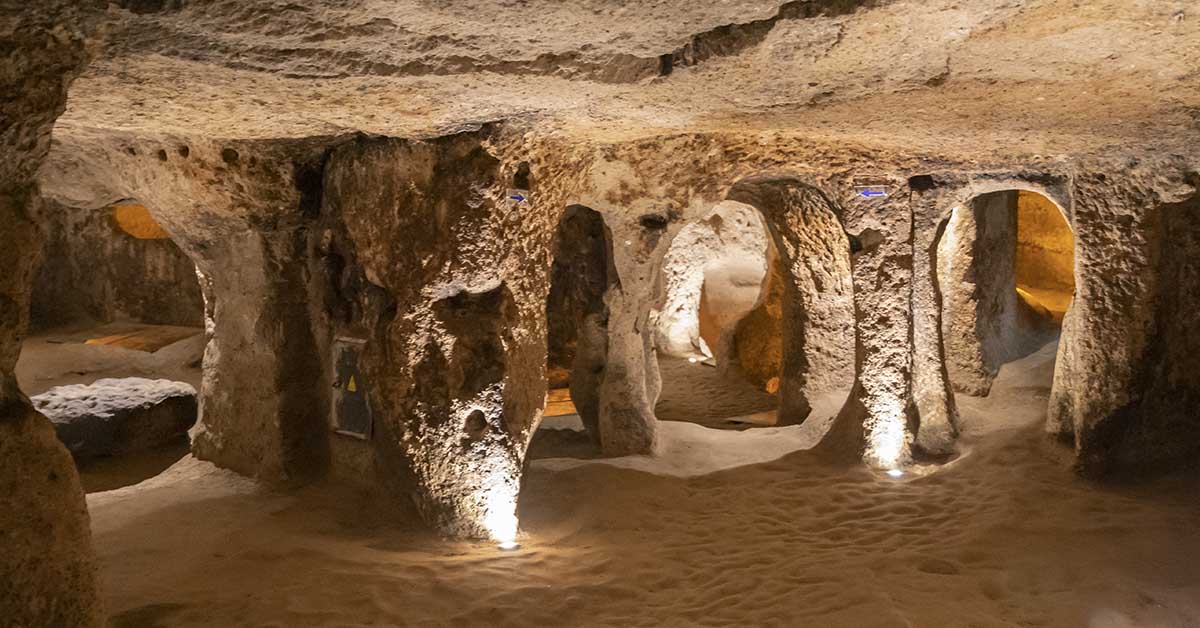In 1963, a man in the Nevşehir Province of Turkey knocked down a wall in his basement and accidentally stumbled into an ancient underground city. The man, who was not named in reports, was renovating his home when his chickens started disappearing into a small crevasse. He investigated the wall with a sledgehammer — only to find a tunnel on the other side. It led to more tunnels, and eventually to a city with stables, schools, and chapels — all 18 stories underground. Fortunately for the unsuspecting man, the city called Derinkuyu was empty, although it had once housed about 20,000 people.
The Subterranean City of Derinkuyu
According to archaeologists at the Turkish Department of Culture, people may have begun building the city back in the 7th or 8th centuries BCE. Derinkuyu is located in today’s Cappadocia, a region in Turkey known for its craggy landscape and stone towers caused by erosions of rocks called tuff, which are created out of volcanic ash. This stone is actually soft, which has allowed locals to dig underground dwellings, refuges, temples, and storage spaces. Therefore, Derinkuyu, originally called Elengubu, isn’t the first subterranean dwelling found here, although it is the largest and most famous. However, it is among hundreds, and 40 of them contain at least two levels.

The origins of Derinkuyu are relatively unknown, although archaeologists have different theories. Some suggest that the Hittites could have built the oldest section around 2000 BC; they had commanded the region at that point. Alternatively, most of the city could have been built by the Phygians around 700 BC. “The Phrygians were one of Anatolia’s most prominent early empires,” said Andrea De Giorgi, associate professor of classical studies at Florida State University. “They developed across western Anatolia around the end of the first millennium BCE and had a bent for monumentalising rock formations and creating remarkable rock-cut facades. Though elusive, their kingdom spread to include most of western and central Anatolia, including the area of Derinkuyu.” [1]
Meanwhile, other archaeologists maintain that Christians living in that area dug the city in the first couple centuries of AD. To prove this theory, additions and alterations in the city appear Christian, these dating from the 6th and 10th century AD. It’s also believed that Christians may have expanded the city after the original builders and used it as a refuge from Roman persecution.
Read: Ancient Bronze Age Couple Found in Loving Embrace 3000 Years After Burial
An Underground Refuge
The main purpose of the city was almost certainly to hide from invading armies. This would account for the large stones that closed off the city from the inside. This place was probably used by the locals to escape the wars between the Arabs and the Byzantines from the 8th century to the 12 century, as well as the Mongol invasions in the 14th century, and during the conquering of the Ottoman Turks. [2]
Additionally, the underground city may have been a seasonal refuge from more extreme temperatures. In that region, summers are unbearably hot and winters can be freezing. But under the earth, the temperature remains mild and moderate. Plus, the people could store their harvest there, away from thieves and moisture that could prematurely rot their food.
No matter who created the city, they were extremely skilled. None of the levels had collapsed despite the potentially thousands of years of wear and tear. Large support pillars protected the floors from cave-ins despite the soft rock surrounding them. Perhaps the biggest concern for an underground city is breathable air.
To solve this, the city holds over 15,000 ventilation shafts. Most of them are about 10 cm wide and extend into the first and second levels. Therefore, these floors became living and sleeping quarters. While there was adequate ventilation down to the eighth level, these lower floors were primarily storage rooms and a dungeon. The levels in between held many functions, from churches, a convent, a wine press, and stalls for animals. The seventh floor held the cruciform church, which may be one of the most well-known sights of Derinkuyu.
Meanwhile, some shafts went longer and deeper underground. In addition to ventilating air, these shafts also served as wells. After the underground city became forgotten, locals would dip their buckets into these wells, oblivious to the secret world beneath them. Perhaps it’s no coincidence that “deep well” in Turkish is derin kuyu.
Read: Perfectly preserved ancient Roman mosaic floor discovered in Italy
Visiting Derinkuyu Today
However, the city wasn’t empty for as long as originally thought. A Cambridge linguist visited the site in the early 20th century and he stated that local Greeks had used Derinkuyu as a refuge during difficult times. “When the news came of the recent massacres at Adana, a great part of the population at Axo took refuge in these underground chambers, and for some nights did not venture to sleep above ground,” Cambridge linguist Richard MacGillivray Dawkins wrote. “It appears […] that until recently the people lived entirely in these subterranean dwellings, without any houses above ground.” [3]
However, their knowledge of the secret place faded after the Greco-Turkish War ended in 1922, and the Cappadocian Greeks fled to Greece, leaving behind Derinkuyu — or Mαλακοπια (Malakopia), the Greek name for the city. It translates as “soft” perhaps in a reference to the surrounding stone.
Today, Derinkuyu is a major tourist attraction in Cappadocia. Visitors can explore the underground city, although it’s not recommended for people with claustrophobia since some tunnels are narrow and involve much ducking and crouching. They can walk through the city’s rooms, stables, and churches, all preserved through time. Another popular underground city in Cappadocia is Kaymakli. It’s located only 10 km away from Derinkuyu and it is notably smaller, with a capacity of about 3,500 people. But visitors can explore four of the eight levels. [4]
Keep Reading: Ancient ritual sees relatives dig up dead relatives and dress them up
Sources
- “Turkey’s underground city of 20,000 people.” BBC Travel. Geena Truman. August 11, 2022
- “Derinkuyu: Mysterious underground city in Turkey found in man’s basement.” Big Think. Frank Jacobs. March 16, 2022
- “A Man Knocked Down His Basement Wall, Discovering Ancient Underground City That Housed 20,000 People.” IFL Science. James Felton. May 17, 2022
- “Exploring Derinkuyu Underground City in Turkey.” We Seek Travel. August 24, 2022

